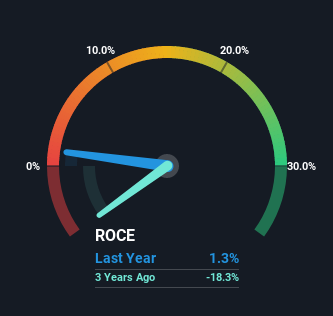- Norway
- /
- Energy Services
- /
- OB:SOFF
Solstad Offshore (OB:SOFF) Shareholders Will Want The ROCE Trajectory To Continue
What are the early trends we should look for to identify a stock that could multiply in value over the long term? Amongst other things, we'll want to see two things; firstly, a growing return on capital employed (ROCE) and secondly, an expansion in the company's amount of capital employed. Put simply, these types of businesses are compounding machines, meaning they are continually reinvesting their earnings at ever-higher rates of return. With that in mind, we've noticed some promising trends at Solstad Offshore (OB:SOFF) so let's look a bit deeper.
Understanding Return On Capital Employed (ROCE)
If you haven't worked with ROCE before, it measures the 'return' (pre-tax profit) a company generates from capital employed in its business. To calculate this metric for Solstad Offshore, this is the formula:
Return on Capital Employed = Earnings Before Interest and Tax (EBIT) ÷ (Total Assets - Current Liabilities)
0.013 = kr260m ÷ (kr26b - kr5.5b) (Based on the trailing twelve months to June 2022).
Therefore, Solstad Offshore has an ROCE of 1.3%. Ultimately, that's a low return and it under-performs the Energy Services industry average of 5.2%.
See our latest analysis for Solstad Offshore

While the past is not representative of the future, it can be helpful to know how a company has performed historically, which is why we have this chart above. If you'd like to look at how Solstad Offshore has performed in the past in other metrics, you can view this free graph of past earnings, revenue and cash flow.
So How Is Solstad Offshore's ROCE Trending?
It's nice to see that ROCE is headed in the right direction, even if it is still relatively low. We found that the returns on capital employed over the last five years have risen by 667%. That's not bad because this tells for every dollar invested (capital employed), the company is increasing the amount earned from that dollar. In regards to capital employed, Solstad Offshore appears to been achieving more with less, since the business is using 46% less capital to run its operation. A business that's shrinking its asset base like this isn't usually typical of a soon to be multi-bagger company.
On a side note, we noticed that the improvement in ROCE appears to be partly fueled by an increase in current liabilities. The current liabilities has increased to 21% of total assets, so the business is now more funded by the likes of its suppliers or short-term creditors. It's worth keeping an eye on this because as the percentage of current liabilities to total assets increases, some aspects of risk also increase.
The Bottom Line On Solstad Offshore's ROCE
In the end, Solstad Offshore has proven it's capital allocation skills are good with those higher returns from less amount of capital. And since the stock has dived 100% over the last five years, there may be other factors affecting the company's prospects. Still, it's worth doing some further research to see if the trends will continue into the future.
One more thing to note, we've identified 2 warning signs with Solstad Offshore and understanding these should be part of your investment process.
While Solstad Offshore may not currently earn the highest returns, we've compiled a list of companies that currently earn more than 25% return on equity. Check out this free list here.
New: Manage All Your Stock Portfolios in One Place
We've created the ultimate portfolio companion for stock investors, and it's free.
• Connect an unlimited number of Portfolios and see your total in one currency
• Be alerted to new Warning Signs or Risks via email or mobile
• Track the Fair Value of your stocks
Have feedback on this article? Concerned about the content? Get in touch with us directly. Alternatively, email editorial-team (at) simplywallst.com.
This article by Simply Wall St is general in nature. We provide commentary based on historical data and analyst forecasts only using an unbiased methodology and our articles are not intended to be financial advice. It does not constitute a recommendation to buy or sell any stock, and does not take account of your objectives, or your financial situation. We aim to bring you long-term focused analysis driven by fundamental data. Note that our analysis may not factor in the latest price-sensitive company announcements or qualitative material. Simply Wall St has no position in any stocks mentioned.
About OB:SOFF
Adequate balance sheet and fair value.
Similar Companies
Market Insights
Community Narratives




